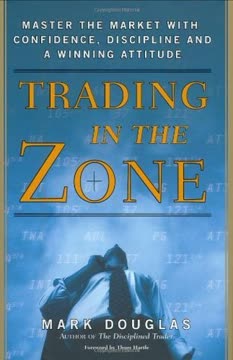Key Takeaways
1. Developing a winning algorithmic trading system requires rigorous testing and emotional discipline
"If it seems too good to be true, it probably is."
Rigorous testing is crucial. Developing a profitable algorithmic trading system requires extensive backtesting, out-of-sample testing, and real-time evaluation. Avoid common pitfalls like curve-fitting, overoptimization, and relying solely on historical data. Test your strategy across multiple market conditions and time frames to ensure robustness.
Emotional discipline is essential. Trading psychology plays a significant role even in algorithmic trading. Be prepared for drawdowns and losing periods, and stick to your predefined rules and risk management guidelines. Avoid the temptation to tweak your system based on short-term results or emotions.
Key components of a robust testing process:
- Historical backtesting
- Out-of-sample testing
- Walk-forward analysis
- Monte Carlo simulation
- Real-time paper trading (incubation)
2. Set SMART goals and create a structured development process for trading strategies
"If you want to accomplish something, you must have goals."
Define SMART goals. Set Specific, Measurable, Attainable, Relevant, and Time-bound goals for your trading system. This provides a clear framework for development and evaluation. For example, aim for a specific annual return with a maximum drawdown limit within a defined timeframe.
Follow a structured process. Create a step-by-step development process to ensure consistency and thoroughness. This should include idea generation, preliminary testing, in-depth analysis, and real-time evaluation. Document each step to maintain clarity and allow for future refinement.
Key stages in the strategy development process:
- Establish goals and objectives
- Generate trading ideas
- Conduct limited testing
- Perform walk-forward analysis
- Run Monte Carlo simulations
- Incubate the strategy in real-time
- Evaluate diversification potential
- Implement position sizing rules
3. Use walk-forward analysis and Monte Carlo simulation to validate trading systems
"Walk-forward analysis tends to produce equity curves that are more stable going forward."
Walk-forward analysis mitigates overfitting. This technique involves optimizing parameters on a portion of historical data and then testing on the subsequent out-of-sample period. Repeat this process multiple times to create a more realistic representation of how the strategy might perform in live trading.
Monte Carlo simulation provides probabilistic insights. By randomizing the order of historical trades, Monte Carlo analysis helps estimate the range of potential outcomes for a trading system. This includes metrics like maximum drawdown, annual return, and risk of ruin, providing a more comprehensive view of the strategy's risk-reward profile.
Key benefits of walk-forward analysis and Monte Carlo simulation:
- Reduced curve-fitting and overfitting
- More realistic performance expectations
- Better understanding of potential drawdowns and risks
- Improved confidence in strategy robustness
4. Diversification across multiple uncorrelated strategies is crucial for long-term success
"Diversification, done properly, is probably the closest thing I've ever seen to the so-called trading 'Holy Grail.'"
Spread risk across strategies. Develop and trade multiple uncorrelated strategies to reduce overall portfolio risk. This helps smooth out equity curves and provides more consistent returns over time. Aim for strategies with different markets, timeframes, and trading styles.
Measure diversification effectiveness. Use correlation analysis, equity curve linearity, and combined Monte Carlo simulations to assess the diversification benefits of your strategy portfolio. Continuously monitor and adjust your strategy mix to maintain optimal diversification.
Methods to achieve strategy diversification:
- Trade different markets (e.g., currencies, commodities, indices)
- Vary timeframes (e.g., intraday, swing, long-term)
- Employ different trading styles (e.g., trend-following, mean-reversion, breakout)
- Use uncorrelated entry and exit rules
5. Position sizing and risk management are as important as the trading strategy itself
"If you trade more contracts, your reward goes up, but so does your risk."
Implement robust position sizing. Develop a position sizing methodology that balances potential returns with acceptable risk levels. Common approaches include fixed fractional, fixed ratio, and optimal f. Regularly review and adjust your position sizing rules based on account equity and market conditions.
Manage risk at multiple levels. Implement risk management at the trade, strategy, and portfolio levels. Set stop-losses, define maximum drawdown limits, and establish criteria for stopping a strategy. Consider using options or other hedging techniques to limit downside risk in extreme market conditions.
Key risk management considerations:
- Per-trade risk limits
- Strategy-level drawdown thresholds
- Portfolio-wide risk allocation
- Correlation between strategies
- Overall account risk of ruin
6. Monitor live strategy performance closely and be prepared to quit underperforming systems
"When your actual performance is below your expected performance, isn't that akin to something or someone stealing from you?"
Track performance metrics. Regularly monitor key performance indicators such as profit factor, Sharpe ratio, maximum drawdown, and win rate. Compare actual results to expected performance based on historical testing and Monte Carlo simulations. Use tools like equity curves and drawdown charts for visual analysis.
Establish clear quit criteria. Define specific conditions under which you will stop trading a strategy. This could be based on maximum drawdown, consecutive losing trades, or a significant deviation from expected performance. Stick to these predefined rules to avoid emotional decision-making during drawdowns.
Performance monitoring tools:
- Daily/weekly performance charts
- Equity curves with standard deviation bands
- Drawdown analysis
- Monte Carlo-based performance ranges
- Strategy correlation matrices
7. Automated trading requires constant vigilance and a plan for handling unexpected issues
"Automated trading does not mean unattended trading."
Stay vigilant. Regularly monitor your automated trading systems for potential issues such as data feed problems, execution errors, or unexpected market conditions. Implement safeguards like daily position checks and automated alerts for unusual activity.
Prepare for the unexpected. Develop contingency plans for various scenarios, such as power outages, internet disruptions, or software glitches. Have backup systems in place and clearly defined procedures for manual intervention when necessary. Regularly test and update your disaster recovery plans.
Key considerations for automated trading:
- Robust error handling in trading algorithms
- Redundant internet connections and power supplies
- Clear procedures for manual overrides
- Regular system health checks and maintenance
- Continuous monitoring of trades and positions
Last updated:
FAQ
What's Building Winning Algorithmic Trading Systems about?
- Focus on Algorithmic Trading: The book details Kevin J. Davey's journey from a novice to a successful algorithmic trader, emphasizing the development of mechanical trading systems using data analysis and statistical methods.
- Comprehensive Guide: It covers system design, testing, and live trading, providing a practical guide for traders at all levels to create and implement their own trading systems.
- Real-Life Experiences: Davey shares personal anecdotes and lessons from his trading career, offering relatable insights into the trading world.
Why should I read Building Winning Algorithmic Trading Systems?
- Learn from Experience: Kevin J. Davey is a proven trader with significant success in trading competitions, offering practical and applicable insights.
- Structured Approach: The book provides a systematic methodology for developing trading systems, including testing methods like Monte Carlo analysis and walk-forward testing.
- Diverse Audience: It offers valuable information for both beginners and experienced traders to enhance their trading strategies and decision-making processes.
What are the key takeaways of Building Winning Algorithmic Trading Systems?
- Importance of Testing: Rigorous testing, including historical back-testing and Monte Carlo analysis, is crucial to ensure trading systems are robust.
- Psychological Aspects: Understanding and managing psychological challenges is essential for maintaining discipline and confidence in trading.
- Continuous Improvement: Traders should regularly evaluate and adapt their strategies based on performance data for long-term success.
What is Monte Carlo analysis in Building Winning Algorithmic Trading Systems?
- Simulation of Trade Outcomes: Monte Carlo analysis simulates potential outcomes by varying the order of trades, assessing risk and potential drawdowns.
- Understanding Risk: It helps traders understand the likelihood of different outcomes, crucial for effective risk management.
- Input Requirements: Requires inputs like starting equity and expected trades to generate a realistic picture of strategy performance.
How does Kevin J. Davey suggest developing a trading system in Building Winning Algorithmic Trading Systems?
- Set SMART Goals: Emphasizes setting Specific, Measurable, Attainable, Relevant, and Time-bound goals for clarity and direction.
- Iterative Testing Process: Recommends evaluating strategies in stages to identify viable ones without overfitting to historical data.
- Focus on Entries and Exits: Encourages developing clear rules for both entry and exit strategies to enhance profitability.
What is walk-forward analysis as described in Building Winning Algorithmic Trading Systems?
- Testing Methodology: Involves optimizing a strategy over a period and testing it on subsequent out-of-sample data to assess adaptability.
- In-Sample and Out-of-Sample: Divides analysis into periods for optimization and testing, helping avoid overfitting.
- Realistic Performance Expectations: Provides a realistic expectation of strategy performance in live trading by identifying potential weaknesses.
What are the common pitfalls in algorithmic trading mentioned in Building Winning Algorithmic Trading Systems?
- Over-Optimization: Tweaking strategies excessively to fit historical data can lead to poor live performance.
- Ignoring Market Changes: Failing to adapt strategies to changing conditions can render them ineffective.
- Emotional Decision-Making: Emotions can influence decisions, making discipline crucial for sticking to strategies.
How can I ensure my trading strategy is robust as per Building Winning Algorithmic Trading Systems?
- Rigorous Testing: Use historical back-testing, walk-forward analysis, and Monte Carlo simulations to validate performance.
- Diversification: Incorporate multiple uncorrelated strategies to reduce risk and improve performance.
- Continuous Monitoring: Regularly evaluate real-time performance against historical expectations for timely adjustments.
How does Building Winning Algorithmic Trading Systems address trading psychology?
- Emotional Management: Emphasizes managing emotions to prevent impulsive decisions and maintain discipline.
- Building Confidence: Shares strategies for building confidence, crucial during drawdowns to stick to strategies.
- Learning from Mistakes: Encourages viewing mistakes as learning opportunities to foster resilience and improve performance.
What are the best quotes from Building Winning Algorithmic Trading Systems and what do they mean?
- "If it seems too good to be true, it probably is.": Cautions against over-optimizing systems and stresses realistic expectations.
- "You must have goals.": Highlights the necessity of setting clear objectives for direction and focus.
- "Treat your data with utmost care!": Stresses the importance of accurate data for reliable strategy testing and success.
How does Monte Carlo simulation work in trading strategies according to Building Winning Algorithmic Trading Systems?
- Risk Assessment Tool: Simulates thousands of outcomes to assess risk and potential performance based on historical data.
- Statistical Analysis: Evaluates metrics like probability of ruin and expected drawdown, providing insights into strategy performance.
- Informed Decision-Making: Helps traders make informed decisions about position sizing and risk management.
How does the author suggest handling losing trades in Building Winning Algorithmic Trading Systems?
- Accepting Losses: Emphasizes accepting losses as a natural part of trading to avoid emotional decision-making.
- Reviewing Performance: Advises reviewing performance to determine if losses are due to strategy flaws or market fluctuations.
- Sticking to the Strategy: Encourages consistency in following the trading plan despite short-term losses for long-term success.
Review Summary
Building algorithmic trading systems, + website receives mostly positive reviews, with an average rating of 4.05/5. Readers appreciate the practical, step-by-step approach to developing trading systems, including backtesting, walk-forward analysis, and Monte Carlo simulations. Many find it informative for beginners and experienced traders alike. Some criticize its focus on futures trading and repetitiveness in certain sections. Overall, readers value the book's realistic perspective on algorithmic trading and its potential pitfalls, with some considering it essential reading for aspiring algo traders.
Similar Books










Download PDF
Download EPUB
.epub digital book format is ideal for reading ebooks on phones, tablets, and e-readers.





